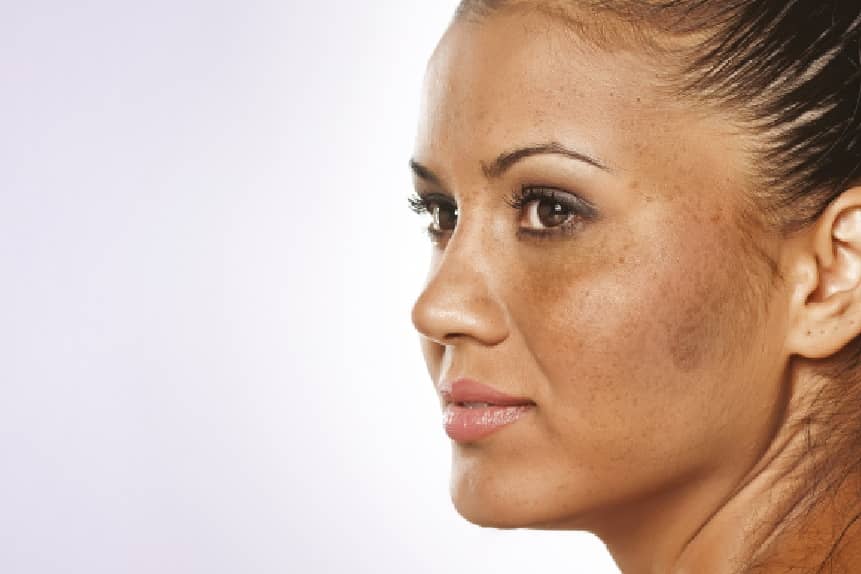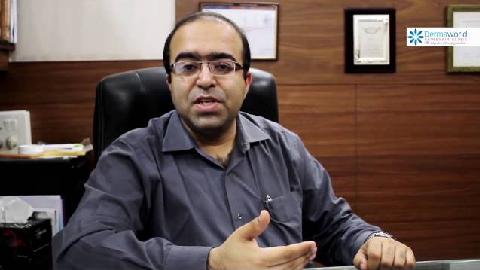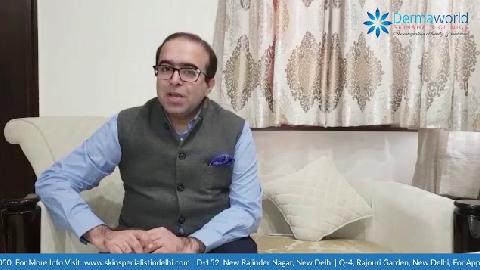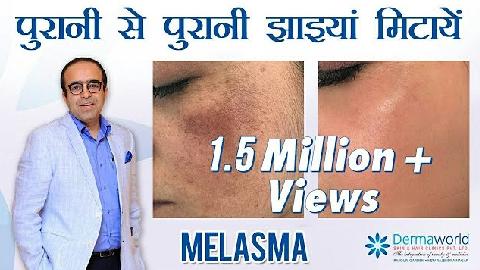
Factors causing melasma
- Hormonal changes that occur due to hormonal therapy, pregnancy, and contraceptive pills.
- Excessive production of melanin due to malfunction of the melanocytes results in skin darkening.
- Melanin producing cells are stimulated by the UV rays that come from excessive sun exposure.
- Several skincare products that can irritate the skin.
- A family history related to pigmentation.
Best Melasma Treatment Doctors at Dermaworld Skin Clinic
Melasma is a common problem of hyperpigmentation that causes dark brown marks on the skin including the face, neck, shoulders, chest, and forearms. In 10% of cases, melasma can occur in men. Commonly women who are pregnant and have dark skin complexion are more likely to get affected by melasma. The primary symptom of melasma can be determined by the appearance of discolored patches on the skin. The main reason for melasma is still unclear. It occurs when the melanocytes (skin color-producing cells) produce too much pigment in the skin, as a result of environmental triggers or genetics. People with dark skin color are more likely to get melasma due to the presence of active melanocytes than people with light skin color.
Diagnosis
- The skin expert diagnoses melasma by visual examination.
- Sometimes, a biopsy is required because melasma resembles other skin diseases. During the biopsy, a small area of the skin is examined for melasma.
- Use of wood’s light for visualizing the skin to diagnose melasma.
Treatment
Laser (Light Amplification by Stimulating Emission of Radiation) is an effective treatment for various types of pigmentation. During this treatment, the laser machine emits a wavelength that is particularly absorbed by specific chromophores (dark patches). It enters into deeper layers of the skin and reduces pigmentation or melasma by breaking the pigmented cells. This treatment does not cause any damage to the skin. Rather it provides the skin a healthier and younger look.
Book An Appointment
ALL CLINICS CLOSED ON SUNDAY
The procedure of laser toning
Laser toning involves a wavelength of 1064 nm and works by deeply penetrating in the pigmented or targeted skin area. During this treatment, the largest spot, which is 6 to 10 mm, should be chosen on the system. This treatment works by the frequency of 0.8 and 2 J/cm2, which depends on the spot size of the laser. It uses a collimated flattop light beam, small pulse duration, large spot size, low fluency, and multiple passes of Q-switched laser that damage the melanocytes. However, it destroys melanocytes, melanosomes, and keratinocytes but does not cause any damage to cell membrane and nucleus; this is termed as ‘subcellular selective photothermolysis’.
Melasma can also be treated by various methods such as topical medications, chemical peels, oral medications, and other light therapies. Melasma can be avoided by first-line treatment such as topical and sunscreen, second-line treatment such as chemical peels, and third-line treatment such as laser and light-based devices.
After completion of the procedure, a broad-spectrum sunscreen is used.
Laser toning is an effective procedure to treat melasma by reducing the size, pigmentation, and homogeneity of melasma patches.
Sun is the major factor causing melasma, therefore, sun protection is a must to prevent it from occurring and reoccurring. So, the use of a dermatologist-recommended sunscreen and its application every two hours is suggested. Wearing a wide-brimmed hat can help to prevent the skin from sun damage.
Frequently Asked Questions
Melasma is a common skin condition that causes brown, tan, and blue-gray spots on the face. Various factors are responsible for causing melasma, such as UV exposure, genetics, waxing, stress, lifestyle, thyroid problems, and change in hormones. This skin condition is not painful and doesn't cause any health risks, but it causes emotional distress in the affected individual.
Other factors that cause melasma include:
- Pregnancy
- Use of birth control pills
- Stress
- Unhealthy lifestyle
- Use of harsh cosmetics
- Injury
- Underlying medical disease
- Lack of skincare
- Certain medications
Melasma is a dysfunction of the skin's pigmentation mechanism. Lasers such as ablative C02 laser and non-ablative fractional lasers (Q-switched laser Nd: YAG laser) are effectively used to treat this condition. The laser heat changes the molecular structure of melanin, and then the immune system becomes alert by the presence of altered melanin. The immune system then dissolves the altered melanin (because they consider them as a foreign substance). Sometimes different types of lasers are used to treat melasma, and multiple sessions are recommended to get the best results.
Melasma cannot be self-treated, and it is recommended to consult a dermatologist to treat this skin condition. The dermatologist first diagnoses the skin condition by visual examination and then diagnoses the root cause of the disease. Then further provides treatments like topical creams, chemical peels, microdermabrasion, dermabrasion, and lasers to treat this skin condition. But, one can apply aloe vera, mulberry extract, turmeric, and drink green tea (rich in antioxidants and anti-inflammatory properties) to prevent the worsening of melasma.
The following factors cause worsening of melasma:
- Excessive sun exposure
- Lack of skincare and hygiene
- Less consumption of water
- Dull and dehydrated skin
- No application of sunscreen
- Trying home remedies without consulting a doctor
- Strongly exfoliating and scrubbing the skin
- Smoking and alcohol consumption
- Regular use of birth control pills
- Consuming oily a junk food
- Lack of antioxidants and mineral-rich diet
Treatment for melasma includes topical, oral and advanced treatments:
Topical treatments:
- Azelaic acid
- Kojic acid
- Ascorbic acid
- Niacinamide
Oral treatments:
- Medications that interrupt plasminogen binding with keratinocytes.
- Antioxidants that lighten the skin tone and protect the skin from free radical damage.
Advanced treatments:
- Chemical peel
- Laser and light-based treatment
- Microneedling




